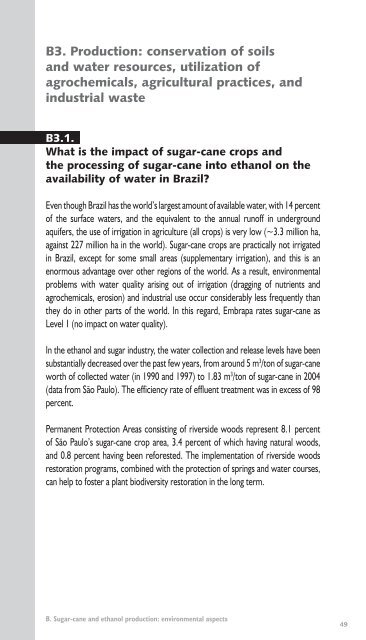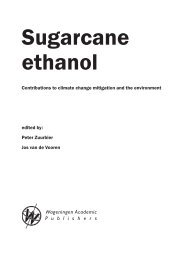Production and use of fuel ethanol in Brazil - BAFF
Production and use of fuel ethanol in Brazil - BAFF
Production and use of fuel ethanol in Brazil - BAFF
You also want an ePaper? Increase the reach of your titles
YUMPU automatically turns print PDFs into web optimized ePapers that Google loves.
B3. <strong>Production</strong>: conservation <strong>of</strong> soils<br />
<strong>and</strong> water resources, utilization <strong>of</strong><br />
agrochemicals, agricultural practices, <strong>and</strong><br />
<strong>in</strong>dustrial waste<br />
B3.1.<br />
What is the impact <strong>of</strong> sugar-cane crops <strong>and</strong><br />
the process<strong>in</strong>g <strong>of</strong> sugar-cane <strong>in</strong>to <strong>ethanol</strong> on the<br />
availability <strong>of</strong> water <strong>in</strong> <strong>Brazil</strong>?<br />
Even though <strong>Brazil</strong> has the world’s largest amount <strong>of</strong> available water, with 14 percent<br />
<strong>of</strong> the surface waters, <strong>and</strong> the equivalent to the annual run<strong>of</strong>f <strong>in</strong> underground<br />
aquifers, the <strong>use</strong> <strong>of</strong> irrigation <strong>in</strong> agriculture (all crops) is very low (~3.3 million ha,<br />
aga<strong>in</strong>st 227 million ha <strong>in</strong> the world). Sugar-cane crops are practically not irrigated<br />
<strong>in</strong> <strong>Brazil</strong>, except for some small areas (supplementary irrigation), <strong>and</strong> this is an<br />
enormous advantage over other regions <strong>of</strong> the world. As a result, environmental<br />
problems with water quality aris<strong>in</strong>g out <strong>of</strong> irrigation (dragg<strong>in</strong>g <strong>of</strong> nutrients <strong>and</strong><br />
agrochemicals, erosion) <strong>and</strong> <strong>in</strong>dustrial <strong>use</strong> occur considerably less frequently than<br />
they do <strong>in</strong> other parts <strong>of</strong> the world. In this regard, Embrapa rates sugar-cane as<br />
Level 1 (no impact on water quality).<br />
In the <strong>ethanol</strong> <strong>and</strong> sugar <strong>in</strong>dustry, the water collection <strong>and</strong> release levels have been<br />
substantially decreased over the past few years, from around 5 m 3 /ton <strong>of</strong> sugar-cane<br />
worth <strong>of</strong> collected water (<strong>in</strong> 1990 <strong>and</strong> 1997) to 1.83 m 3 /ton <strong>of</strong> sugar-cane <strong>in</strong> 2004<br />
(data from São Paulo). The efficiency rate <strong>of</strong> effluent treatment was <strong>in</strong> excess <strong>of</strong> 98<br />
percent.<br />
Permanent Protection Areas consist<strong>in</strong>g <strong>of</strong> riverside woods represent 8.1 percent<br />
<strong>of</strong> São Paulo’s sugar-cane crop area, 3.4 percent <strong>of</strong> which hav<strong>in</strong>g natural woods,<br />
<strong>and</strong> 0.8 percent hav<strong>in</strong>g been reforested. The implementation <strong>of</strong> riverside woods<br />
restoration programs, comb<strong>in</strong>ed with the protection <strong>of</strong> spr<strong>in</strong>gs <strong>and</strong> water courses,<br />
can help to foster a plant biodiversity restoration <strong>in</strong> the long term.<br />
B. Sugar-cane <strong>and</strong> <strong>ethanol</strong> production: environmental aspects<br />
49












